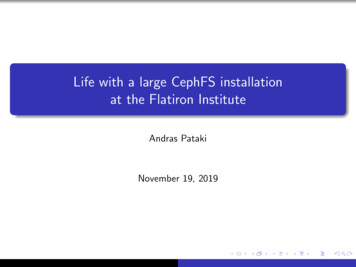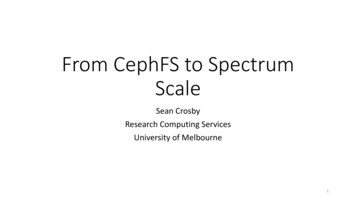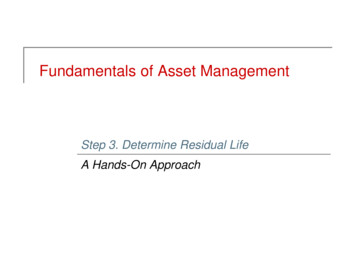
Transcription
Life with a large CephFS installationat the Flatiron InstituteAndras PatakiNovember 19, 2019
Flatiron Institutewww.flatironinstitute.orgInternal research division of the Simons FoundationMission: to advance scientific research through computational methods,including data analysis, modeling and simulationOrganized into centersCenter for Computational Astrophysics (CCA)Center for Computational Biology (CCB)Center for Computational Quantum Chemistry (CCQ)Center for Computational Mathematics (CCM)Scientific Computing Core (SCC)Young institution - extremely fast growth
Flatiron InstituteData of a variety of sorts .Large genomics datasets from sequencersAstrophysics simulation outputsVariety of computational styles .Embarrassingly parallel: genomics pipelinesLoosely coupled MPI: protein folding, some quantum chemistry codesTightly coupled MPI: astro sims
Flatiron InstituteComputational resourcesAbout 40k cores of computing20k in New York (Manhattan and Brookhaven National Labs)20k at the San Diego Supercomputer Center (SDSC) 200 GPUsAlmost 30PB of raw space in Ceph storage (Manhattan)about 10PB used - in 250 million filesAlso GPFS and Lustre storageCeph @ FlatironStarted using CephFS with Hammer in 2015Initially on a small scale - a few hundred TBGrew to a large setup - as our research areas expanded
Flatiron Ceph ImplementationDense storage nodes from Dell (DSS-7500)90 x 8TB 7200rpm SAS drives, 2 x 28 core Broadwell servers in 4Udual 40Gbps ethernet
Flatiron Ceph Implementation
Flatiron Ceph ImplementationCurrent system:42 DSS-7500 storage servers (84 nodes)5 monitor nodes6 metadata storage nodes
Topics for todayThree topics for today:Planning for failures - how you “crush” itTriple replication vs. erasure codingMonitoring performance - troubleshooting user issues
Flatiron Ceph Data PlacementUnique challenge of Flatiron Data CenterIn basement - on an island a few feet above sea levelDistributed Ceph storage nodes around the buildingConfigured data placement using the flexibility of CRUSHNo failure of a single area (room) will result in a loss of dataBuilding is divided into 3 regionsLoss of one region (such as the basement) results in no data lossIt has a theoretical overhead of 50 percentEncodingTriple replication - used for metadata and small filesErasure coding (6 3) - used for large filesActual overhead - very close to theoretical
Failures and ResilienceTypical failures:Single drive failures, read/write errors - Ceph handles automaticallySometimes node crashes - mostly hardware reasonsManual intervention - no automatic recoveryDIMM replacementsRarely - NVMe failure, SAS controller failureAvailability:With one exception - we had no unplanned outages on the DSS-7500 setupWe moved Ceph data to our new building without interrupting availabilityWe have done upgrades of ceph without a shutdownReal Disaster Recovery:Tenant above one of our floors left the water running over a weekendOne of the data closets got flooded with a 90 drive ceph node in itWater electricity troubleHowever - we lost no data
Flooded ceph node electrical fire
Triple replication vs. Erasure codingWhy triple replication?SimplerLower recovery costsSignificantly better for small filesSmall files already trigger lots of seeks and small readsEC makes the reads even smaller and spreads them to multiple drives. but . it wastes space
CephFS Performance - 1Test setup:36 DSS-7500 servers64 client nodes with 10GbETriple replicated poolSequential write/read
CephFS Performance - 2Test setup:36 DSS-7500 servers64 client nodes with 10GbE6 3 EC profile poolSequential write/read
File size distributionOur approach with the “triple replication vs. erasure coding” question:Store small files as triple replicatedMigrate large files to EC pool for long term storage
Flatiron CustomizationsReal time usage monitoring is a challenge with most distributed FS’sHow much I/O do individual nodes and/or users do?What type of I/O do they do? small files, large continuous read/writesIf there is a performance problem - which job is causing it?Our answer - client side data collection:We run a modified Ceph client - collects real time usage statisticsMakes it possible to identify problematic jobsexamples: opening thousands of files a second, doing small I/O
Flatiron Customizations
Current ChallengesSmall file performanceUse kernel clientStabilityKernel version dependenceUsage monitoring instrumentationCeph Octopus planned improvements - small file creation/removalTestament to flexible design of CephSimultaneous I/O to the same file (MPI-IO)Future ceph building blocksDSS-7500 is a bit disk heavy - has not seen any architecture updatesFlash storage nodeEspecially when small file performance improvesCeph has a project (Crimson) - OSD optimized for low latency flashLonger termHSM like functionality - moving old data to tape or colder storage
Almost 30PB of raw space in Ceph storage (Manhattan) about 10PB used - in 250 million les Also GPFS and Lustre storage Ceph @ Flatiron Started using CephFS with Hammer in 2015 Initially on a small scale - a few hundred TB Grew to a large setup - as our research areas expanded










